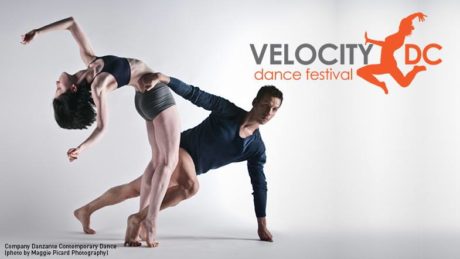Velocity is speed with purpose: a change in distance over time, crucially defined by direction. The VelocityDC Dance Festival took us in many. In its ninth iteration, the variety-style performance, presented at Sidney Harman Hall in partnership with the DC Commission on the Arts & Humanities, the Shakespeare Theatre Company, and Washington Performing Arts, showcased a diversity of influence but common unity of intention from the dance community of the nation’s capital. The performers and choreographers moved us all over the world (West Africa, India, urban spaces at the root of hip-hop, Europe, El Salvador, New Orleans, and back to DC again) in the span of two hours, on the same uplifting path.
A percussive swell of sound and joyful energy from Coyaba Dance Theater signaled the start. Founded in 1997, the company emphasizes the dance technique and traditions of the Mali Empire (Guinea, Senegal, and Mali). Dancers and drummers alike entered in line, stepped and beat and stepped and beat. “Wake up!” called Artistic Director Sylvia Soumah—but it had already happened, just moments after their appearance. While dancing, Soumah pointed and smiled to silhouettes in the first few rows, calling us out of ourselves and into the other half of the half-circle formed on stage.
Emcee Regie Cabico, spoken word artist, part of two seasons of HBO’s Def Poetry Jam, segued into Prakriti Dance, another one of the night’s most memorable performances. Coming up next will be a story of “water, birds, and cognitive thought,” dangled Cabico. Choreographer and dancer Kasi Aysola, alongside his partner Madhvi Venkatesh, then spoke of Amritesvari, goddess of celestial waters, with the language of Bharata Natyam, the Indian classical dance form. Aysola’s words were his wrists—undulating, flicking, and cascading. In one moment, though inches apart, he and Venkatesh’s fingers looked tethered, magnetically pulled by the same energy, history, the same her and his story.

Urban Artistry’s upbeat and hard-hitting choreography successfully spoke volumes in a small amount of stage floor, the goal of its explorative and media-complemented Ace of Space: Hip Hop’s Social Spaces. Self-described as the “cultural ambassadors for communities that are often unsung,” Rizqi Rachmat (dancer and choreographer), Diyanna Burton, Johnte Cunningham, Malachi Jean, Jack Liang, Leslie Liao and Avery Matthews explored the venues of characteristic of traditional hip hop: the street corner, porch, and park bench.
The evening also included numerous contemporary and lyrical works that could have, on the whole, benefited from more range between them in the selected musical accompaniment. Many of these pieces struck and repeated the same dynamic chord.
Of these modern pieces, though, DC Contemporary Dance Theatre/El Teatro de Danza Contemporanea, which “reflects the power, passion and poetry of Latin America,” spun its own haunting version of a bird narrative and left a poignant image in the audience’s imagination: the entire company clustered center stage, in varied depths of second position plié, arms bending at the elbow, up and down, left and right—a breathing, pulsating nest—feathers poised for the next flight. Company members Maurice Johnson and Kate Page particularly elevated the modern/ballet technique level of the ensemble.
Eminent contemporary/ballet technique and complexity of lyrical choreography also separated PrioreDance’s “Casita” and Therese Gahl’s “Cerulean Contemplation” from the contemporary numbers. Casita, small house in Spanish, is “an exploration of the connection we make with the family we create, not the one we are born into.” The beauty of this group piece was its adherence to that core message. The synchronization of pirouettes, attitude turns and jumps created one force, almost one body. Gahl, trained at The Washington Ballet, who taught and now choreographs for CityDance School and Conservatory, peppered “Cerulean” with demanding sequences of ballet-inspired lyrical steps that were seamlessly performed.
The National Hand Dance Association dialed the District back to the ‘50s and ‘60s but dialed the cool in the room up more than several degrees. Oozing style and real social interaction (not thumbs texting frantically but making “friends,” or more than friends, eye-to-eye, face-to-face), expert couples performed its eponymous dance, the official dance of Washington, D.C. Both generations of couples, the Old and New School dancers, were officially smooth. “Oohs” and “aahs” sounded out from the crowd, and I wondered if pairs from the audience would float up and join them.
Luckily for viewers anxious to learn, the group gave a free post-show dance lesson to eager audience members, and the party only kept growing. Some joined in, introduced themselves to a new partner. Some watched, smiling, a foot tapping here and there. There we were, walking the path we came in but stepping back out into D.C., our collective stage, a little more awake, a little more in motion—our diverse directions our greatest strength.
Running time: Two hours and twenty minutes, with a twenty minute intermission.
VelocityDC Dance Festival played Friday, October 6 and Saturday, October 7, 2017 at 8:00 p.m., with a modified family matinée on Saturday, October 7 at 2:00 p.m. at 610 F Street NW Washington, D.C.





